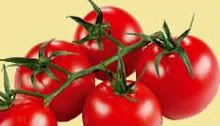Some Interesting Facts About Tomatoes

Ask what color tomatoes are, and the answer will most likely be "red." But did you know that varieties can be yellow, orange, pink, purple, brown, white, or green, and some are even striped? Not all are round. Some are flat or plum- or pear-shaped. They can be as small as a pea or as large as a man's clenched fist.
This popular food is grown as far north as Iceland and as far south as New Zealand. Major producers are the United States and southern European countries. Cooler climates rely on greenhouse production, and arid regions grow the crop by hydroponic techniques-that is, in a nutrient solution without soil.
And talking about hydroponics in the growing of tomatoes, a huge land development known as Thanet Earth in the South of England has been created to grow millions of fruit and vegetables, including tomatoes.
The greenhouses are large enough to contain ten football pitches in fact. Each greenhouse will be 1,240ft long, centrally heated and fed by its own private reservoir.
The results as far as tomatoes are concerned will be that every week of the year a staggering 2.5 million tomatoes will be cropped. Whether they are as tasty as those grown in soil will be debated by some for a long time to come I daresay.
The tomato remains a favorite of the amateur gardener. It is easy to grow, and a few plants provide enough tomatoes to feed a small family. If you have limited space, look for varieties specially developed for patios and window boxes.
Cold temperatures impair the flavor of tomatoes, so do not store them in the refrigerator. To speed up the ripening process, you could set them on a sunlit windowsill or you could keep them at room temperature in a bowl with a ripe tomato or banana or in a closed brown paper bag for a few days.
Tomatoes are good for you. They contain vitamins A, C, and E, as well as potassium, calcium, and mineral salts. Tomatoes contain high levels of beta-carotene, an antioxidant that supports the immune system and helps maintain healthy skin and tissue lining. Tomatoes are 93 to 95 percent water, and weight watchers will be glad to know that they are very low in calories.
When you buy tomatoes, what type will you choose? The familiar red, classic variety are useful for salads, soups, and sauces. The tiny red, orange, or yellow cherry tomatoes, which are very sweet because they have a high sugar content, are delightful eaten raw. If you are making a pizza or a pasta dish, maybe the oval-shaped plum tomato with its firm flesh would be a good choice. The large beefsteak tomato-called such because of its dense, beefy flesh-is ideal for stuffing or baking. The green tomato, sometimes with distinctive stripes, makes excellent relish. Indeed, tomatoes add their distinctive flavor and color to a huge range of delicious vegetable, egg, pasta, meat, and fish dishes. If you cannot obtain fresh tomatoes, no doubt you will find many processed tomato products in your local store.
Here are a few suggestions you may want to try.
1. Prepare a quick and colorful appetizer by overlapping slices of tomato, mozzarella cheese, and avocado. Sprinkle with a dressing of olive oil and black pepper, and garnish with basil leaves.
2. Make a Greek salad by combining chunks of tomato, cucumber, and feta cheese with black olives and sliced red onion. Season with salt and pepper, and serve with a dressing of olive oil and lemon juice.
3. Create a Mexican salsa with freshly chopped tomato, onion, green chillies, and coriander, mixed together with a little lime juice.
4. Produce a simple yet tasty tomato sauce for pasta by placing in a pan the contents of a can of chopped tomatoes, a pinch of sugar (or catsup), some olive oil, a minced garlic clove, a few herbs such as basil, bay leaf, or oregano, and some seasoning. Bring the mixture to a boil, and then simmer it for about 20 minutes until the sauce thickens. Pour it over your cooked and drained pasta.




